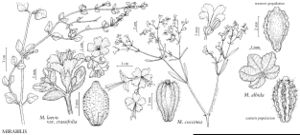Mirabilis coccinea
Gen. Pl. 3: 3. 1880.
Stems ascending to erect, 1.5–9 dm, glabrous basally, glabrous or rarely very sparsely puberulent distally. Leaves usually ascending or spreading at 45–90°, dark grayish green, moderately thick and fleshy; petiole 0–0.3 cm; blade linear to linear-lanceolate, 4.5–10 × 0.1–0.5 cm, base attenuate, apex acute, surfaces glabrous or rarely with few small hairs adaxially, glabrous abaxially. Inflorescences: peduncle 4–8 mm, spreading stiff short hairy or glandular-pubescent, crosswalls of hairs pale; involucres dark green, opaque, moderately veiny, 4–7 mm in flower, 4–8 mm in fruit, softly hirtellous or glandular-hirtellous, bracts 30–40% connate, lobes narrowly ovate or triangular. Flowers: perianth bright red-purple, 1.3–2 cm. Fruits pale olive brown, 4.5–6 mm; ribs round, 0.5–0.8 times width of sulci, 0.5 times as wide as high, smooth or slightly warty or with warts equaling height of ribs; sulci smooth.
Phenology: Flowering late spring–early fall.
Habitat: Dry, open hillsides of igneous rock, shrubs, pinyon-juniper or mixed conifer woodlands
Elevation: 1200-2000 m
Distribution

Ariz., Calif., N.Mex., Mexico (Sonora)
Discussion
Mirabilis coccinea is easily confused with M. linearis var. linearis when the flowers are closed. The distinction is more difficult when plants are cleistogamous (phase Allionia gracillima in M. coccinea; phases A. pinetorum and Oxybaphus bodinii in M. linearis). In general, leaves of M. coccinea are oriented at an angle of 45° or greater to the stem, the distal portion of the main axis of the inflorescence is glabrous to 2–3 cm from the flowers, and the peduncles are sparingly short pubescent. In var. linearis, the leaves are generally oriented at 45° or less to the stem, the inflorescence is densely pubescent, and the peduncles are densely spreading-pubescent. Reports of the occurrence of M. coccinea in Texas (e.g., D. S. Correll and M. C. Johnston 1970) are apparently based on literature records and perhaps on a labeling error of a probable isotype collected by Charles Wright. No specimens have been seen from Texas. P. C. Standley (1911) discussed the unique nature of the fruit and perianth of this species relative to sect. Mirabilis and sect. Oxybaphus; in the original description, Torrey noted the species to be intermediate between Oxybaphus and Quamoclidion.
Selected References
None.
Lower Taxa
"thick" is not a number."dm" is not declared as a valid unit of measurement for this property.
